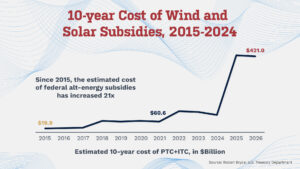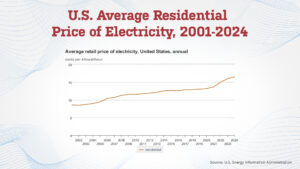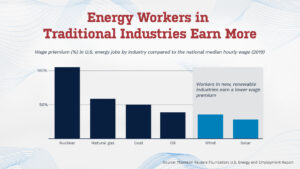
Green Fairy Tales: Coming Soon To Your Inbox
June 2, 2025
These numbers aren’t real.
Over the last few months, you may have heard proponents of Biden’s massively expensive Inflation Reduction Act (IRA) legislation claiming that a repeal of green energy subsidies in the bill will have dire effects. Among those claims, they say that repealing green energy handouts will drive up electricity bills on American families. They say the spending cuts will kill jobs across the nation. They say eliminating the handouts will lower our national GDP. They even say the cuts will cause thousands of “premature deaths.”
One frequently cited “study” comes from an organization called Energy Innovation. They used a proprietary tool they call the “Energy Policy Simulator” to project outcomes they think will come if the IRA’s green energy components are left in place. They claim the IRA “could also create up to 1.5 million new jobs.” They also project that consumer energy bills will be $9 billion higher by 2035 if the green energy IRA handouts are repealed, which they say will translate into an increase of $68 per year in the average American household.
The problem though is hidden in the words that groups like Energy Innovation use to make their claims. Their numbers come from a “simulator” based on “models.” These jobs “could” be created. The rise in energy prices is “projected.”
What does all that mean? It means their numbers aren’t real.
Green energy subsidies have been spiking for years.
So, what do the real numbers say? As we’ve discussed before, the Inflation Reduction Act was certainly not the beginning of exponentially higher federal subsidies going to renewable energy sources over traditional energy sources like natural gas, nuclear and oil.

According to the Institute for Energy Research even before the IRA, “Federal subsidies to support renewable energy formed nearly half of all federal energy-related support between fiscal years 2016 and 2022. Traditional fuels (coal, natural gas, oil and nuclear) received just 15 percent of all subsidies between FY 2016 and FY 2022, while renewables, conservation and end use received a whopping 85 percent. Renewable subsidies more than doubled between FY 2016 and FY 2022, increasing to $15.6 billion in fiscal year 2022 from $7.4 billion in fiscal year 2016 (both in 2022 dollars). Federal subsidies and incentives to support renewable energy in fiscal year 2022 were almost 5 times higher than those for fossil energy, which totaled $3.2 billion in subsidies.”
After the IRA, those number grow even more. As energy expert Robert Bryce points out, from 2015 to 2024 the 10-year cost of wind and solar subsidies called the investment tax credit (ITC) and production tax credit (PTC) increased from just under $20 billion in annual spending to $421 billion. Bryce: “Between 2025 and 2034, the agency expects the ITC to cost $131.4 billion and the PTC to cost $289.6 billion. That $421 billion total is a 21-fold increase since 2015 and a nearly 7-fold increase since 2021, the year before the IRA became law.”

And, they haven’t lowered your electricity bill one bit.
So, based on the projections from organizations like Energy Innovation, all those tax breaks (that come out of the pockets of American taxpayers) for wind and solar energy over the last decade should have resulted in savings on our energy bills, right? Not so much.
According to the Energy Information Administration, the retail price of electricity in the United States has risen at a consistent pace over the last two decades. In 2001, Americans were paying an average 8.58 cents per kilowatt hour for residential electricity. In 2024, that price was 16.48 cents per kilowatt hour, nearly doubling in just over 20 years. And, the biggest uptick on the graph can be seen starting in 2021—just before the IRA became law. From 2021 to 2024, there was a 21% percent increase in the average price American families paid for electricity, and that happened during the exact same period that Biden’s IRA green energy slush fund went into place.

But, what about the jobs?
Of course any energy project—especially one flush with no-strings-attached taxpayer dollars—is going to “create” some jobs, but let’s talk scale. According to the Environmental and Energy Study Institute, renewable energy supported 546,630 American jobs in 2022. The U.S. oil and natural gas industry supports almost 11 million. There is no comparison. And, it is frankly unconscionable for the green-at-all-cost crowd to be accusing leaders of cutting made-up jobs based on their magical clean energy simulator machine, when they have been trying to kill traditional energy industries that employ millions of Americans with very real, stable, good-paying jobs.
If quantity isn’t your thing, let’s talk about quality. Jobs in nuclear, natural gas, coal and oil all pay more than jobs in wind and solar. In 2020, North America’s Building Trades Union (NABTU)—far from a right wing source—conducted a study that found, “Oil and natural gas construction jobs provide workers with better pay, health and pension benefits than other industries.”

Sean McGarvey, President of NABTU: “The research confirms what our members tell us: the career opportunities for renewables are nowhere near what they are in gas and oil, and domestic energy workers highly value the safety, reliable duration and compensation of oil and gas construction jobs.” In a Wall Street Journal opinion piece about the studies, Garvey elaborated even more, estimating that many union members would “take a 50% or 75% pay cut” if they changed jobs into the renewable energy industry.
Green Fairy Tales: Coming to Your Mailbox in Fall 2026
This green doomsday messaging based on simulations and made-up numbers built to a crescendo during the recent budget activities in Congress—even driving some of the hesitation from Republicans to take a vote eliminating this unnecessary spending of taxpayer dollars to prop up the wind and solar industry. While these politicians likely fear they will take a political hit in the 2026 midterm elections—with their districts being inundated with a twisted message that they “voted to kill jobs” or “voted to drive up energy costs”—the reality is this is a political ploy based on some very sketchy “studies” that have little basis in the real world.